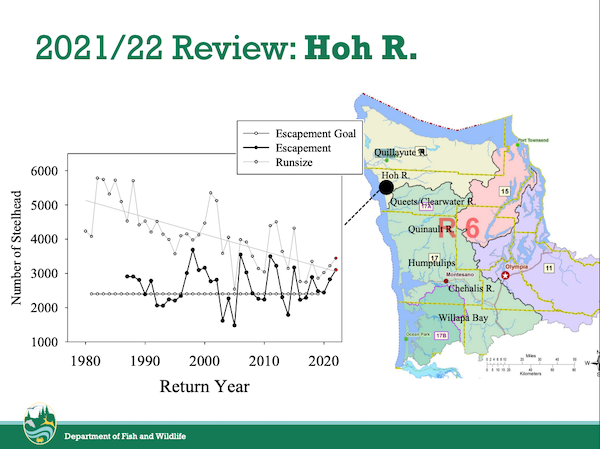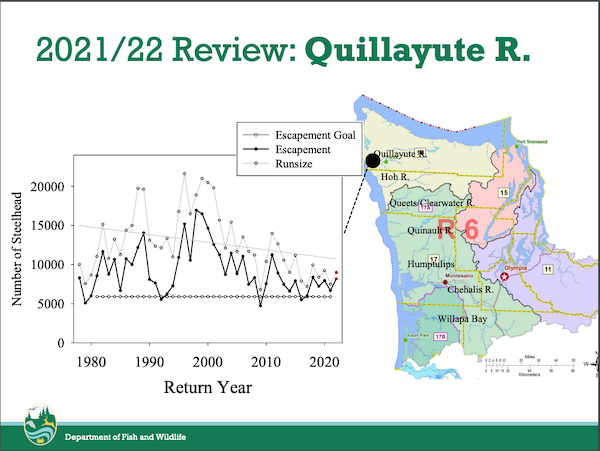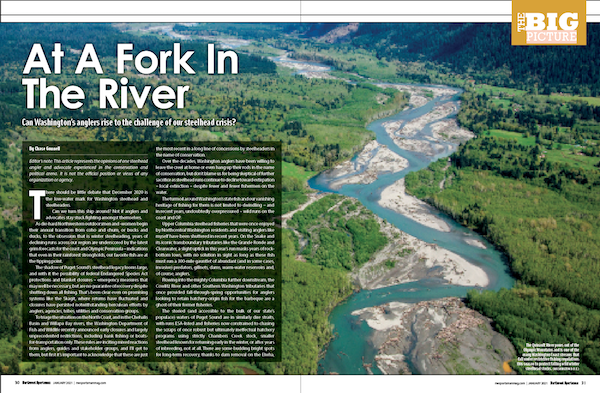
OlyPen Steelhead ESA Listing May Be Warranted, NMFS Finds
Editor’s note: Updated 11:25 a.m., February 10, 2023, in the paragraphs with comments from Forks-based fishing guide Bob Kratzer in the 13th and 14th paragraphs and with two new images immediately afterwards.
A petition to list Olympic Peninsula steelhead under federal Endangered Species Act protections has been accepted by the National Marine Fisheries Service, which will now do a deep dive on the request from the Wild Fish Conservancy and The Conservation Angler.

The review over the coming year will determine whether a threatened and/or endangered listing is needed for what some consider to be the “crown jewel” fish of Washington – winter- and summer-runs that return to fabled rivers such as the Quillayute, Sol Duc, Calawah, Hoh, Queets and Quinault, as well as all other streams from the Copalis just north of Ocean Shores to the Lyre between Sekiu and Port Angeles.
“We find that the petition presents substantial scientific and commercial information indicating the listing may be warranted. We will conduct a status review of OP steelhead to determine whether listing is warranted. To ensure that the status review is comprehensive, we are soliciting scientific and commercial information pertaining to this species from any interested party,” NMFS writes in a prefiling this morning on the Federal Register.
It’s a potentially dark cloud in a storm-lashed land, as what’s known as a 12-month “warranted” finding would lead to a rule proposing an ESA listing, public comment and a final decision whether to publish the rule or withdraw it.
Conversely, NMFS could also determine that a listing isn’t needed, ending the process.

“WDFW plans to review the petition and if requested will provide information to NMFS about steelhead on the Olympic Peninsula. We are committed to advancing coastal wild steelhead conservation by focusing on healthy levels of abundance, productivity, diversity, and distribution, while providing opportunities for anglers,” reads a statement out from WDFW at midmorning.
Peninsula steelhead are jointly managed by the state agency, Olympic National Park, and the Makah, Quileute, Hoh and Quinault Tribes.
Wild Fish Conservancy of Duvall and The Conservation Angler of Edmonds petitioned the feds to list Olympic Peninsula steelhead on August 1.
“The fate of the species now rests on a depressed and contracted mid- to late-spring component of wild fish whose productivity is limited or declining depending on the population. The remnants of these runs that historically numbered in the tens of thousands face declining freshwater and marine habitat conditions, increasing recreational fishing pressure, and ongoing commercial harvest. Because of these and other demographic and ecological threats, Olympic Peninsula steelhead are likely to become endangered within the foreseeable future,” WFC and TCA argued at the time.
A potential listing petition from their camp has been threatened for a couple years now as wild runs have sagged on the Washington Coast. Just 25,723 winter fish were counted on the gravel during the 2020-21 run, a new low mark and roughly half of what it was in 2015, the year of the Blob, which starved streams of snowpack-fueled runoff, denying redds and fry of water and habitat.

Since then, however, returns have clawed their way back up, with 28,406 returning in 2021-22 and state forecasters expecting 30,544 in 2022-23.
In reaction, WDFW has implemented sweeping, unprecedented and continuing fishery restrictions in recent seasons. Along with single-barbless-hook-only and no-bait rules, no fishing from a boat was allowed coastwide in 2020-21, effectively halving the catch. That was eased on portions of the Quillayute system but the other rules remain in place, and there have been early closures each season to protect April and March fish.
Well-known Forks-based guide Bob Kratzer of Angler’s Guide Service had mixed emotions over NMFS accepting the petition for further study, but he held out hope that recent stability and even gains on the Quillayute and Hoh systems might help stave off a listing.
“It saddens me that we are to this point,” said Kratzer, who is also active in fishing guide leadership circles. “I am excited, though, that with the tightening of regulations in 2017 it appears that the North Coast rivers are responding to those. It looks like with two years with closed waters in the south OP and this third again, that there is some positive movement in those runs also. The North Coast streams have have been holding their own and have actually increased in number on a few streams. I am hoping that they see these moves in restoring our runs and hold off on any listing.”


A 1996 status review of Olympic Peninsula steelhead found the stock was “not in danger of extinction or likely to become endangered in the foreseeable future,” though NMFS “was concerned about the overall health of the [evolutionary significant unit] and specific populations.”
Fast forward to today’s prefiling, NMFS now states that with data from the petition and in its own files, even if somewhat lacking, on winter- and summer-run abundance, “a reasonable person would conclude that the information presented in the petition indicates that many OP steelhead populations likely have declined.”
NMFS also states it found that “past and future harvest may be posing threats to the continued existence of OP steelhead” and “that hatcheries and climate change may be posing threats to the continued existence of OP steelhead.”

In late 2015, the Washington Fish and Wildlife Commission ended retention of wild steelhead on state-managed rivers there, a rule change that took effect with the 2016-17 season and effectively ended the sport harvest of natural-origin steelies in state waters. In early 2010, the commission reduced the wild steelhead retention period on eight West End rivers by two and a half months, starting with the 2010-11 season. Prior to that, harvest had been limited to one wild fish a year.
Tribal harvest continues, albeit at lower levels in areas on recent years, given reduced runs; catch data from this season is incomplete.

WFC’s and TCA’s OlyPen petition last August kicked off a 90-day review, give or take, and tomorrow, February 10, what’s known as a “positive” finding on it will be officially published on the Federal Register. Essentially, that determines that a listing may be warranted and opens a 60-day public comment period, and status and peer reviews.
It was one of 10 petitions that had piled up on NMFS’s collective desk last summer and is the second positive finding affecting Northwest salmonid stocks from them in less than a month. On January 12, the feds announced an ESA listing may be warranted for Oregon Coast and far Northern California Chinook. The petition to list those fish was also filed in August, by Native Fish Society, Center for Biological Diversity and Umpqua Watersheds.
As it stands, Washington’s ESA-listed steelhead include those in the Columbia-Snake system from the Cowlitz upstream, and in Puget Sound. After 2007’s listing in the latter region, it took a monumental effort by anglers, guides, WDFW, the Fish and Wildlife Commission and local tribes to reopen the Skagit and Sauk for fishing in late winter via a shorter-term resource management plan approved by NMFS. WDFW and others are still awaiting word whether their new 10-year RMP has been accepted by the federal overseers.
If OlyPen steelhead are eventually federally listed, it would leave Grays Harbor, Willapa Bay and Lower Columbia tribs such as the Grays and Elochoman Rivers and Abernethy and Germany Creeks, among others, as the only waters the state fish is not under ESA protections. Chehalis steelhead are struggling, and fishing has been completely closed for a second straight winter, which likely will lead to another huge surplus of hatchery steelhead in the Wynoochee and Skookumchuck Rivers, among others, that will be put into lakes again – a very sore point with anglers but a fishery that was the subject of a WDFW blog on Wednesday.
A WDFW request for $5.9 million mostly for steelhead fishery monitoring and management up and down the coast is in budgetary limbo and wasn’t included in the Governor’s budget, but state lawmakers could still fold it into their proposals.
“We submitted a framework and funding request to the legislature that would inform the development of comprehensive steelhead management plans for coastal steelhead populations. We’re hopeful this important work is funded this session,” WDFW also stated this morning.

